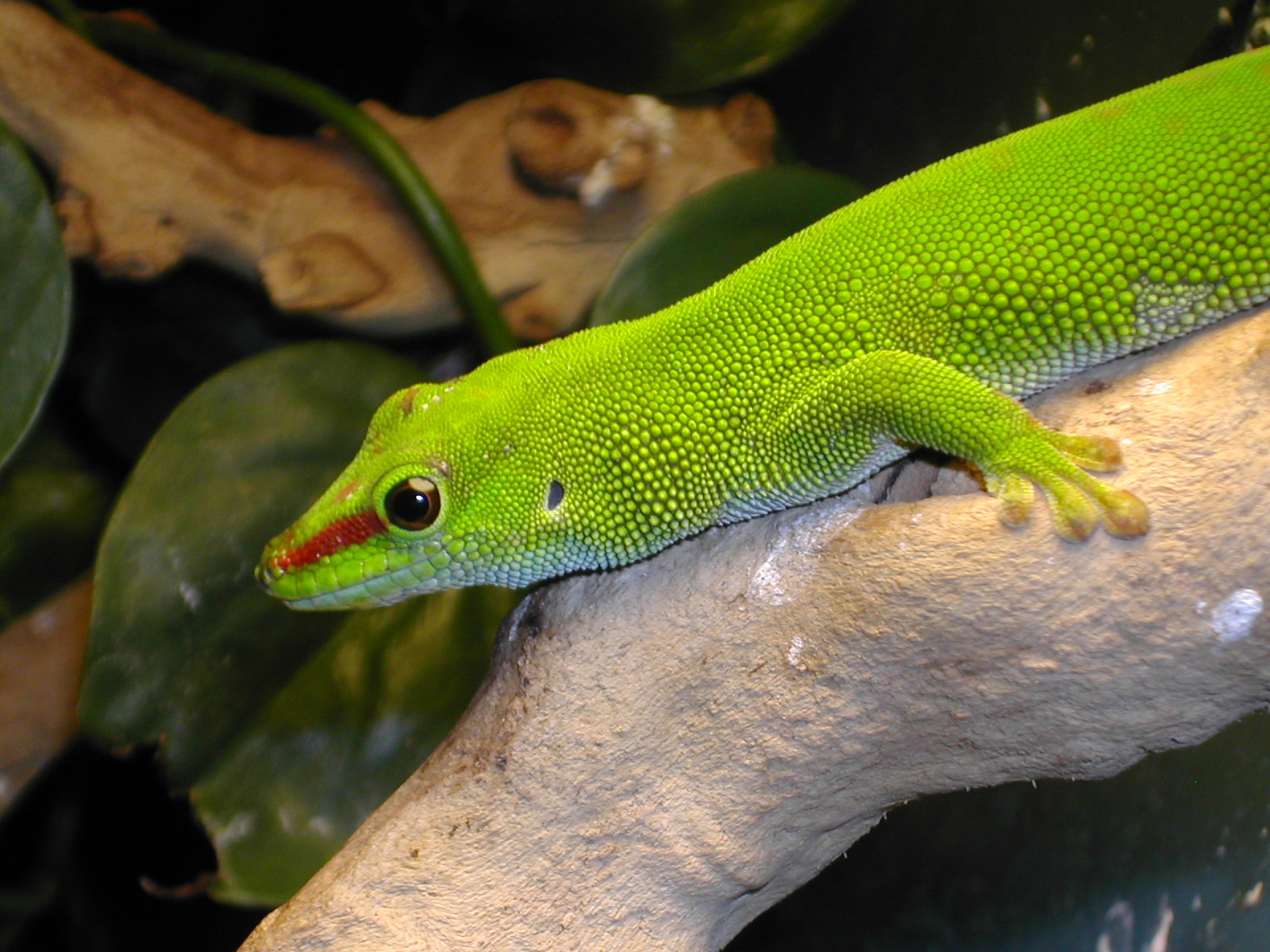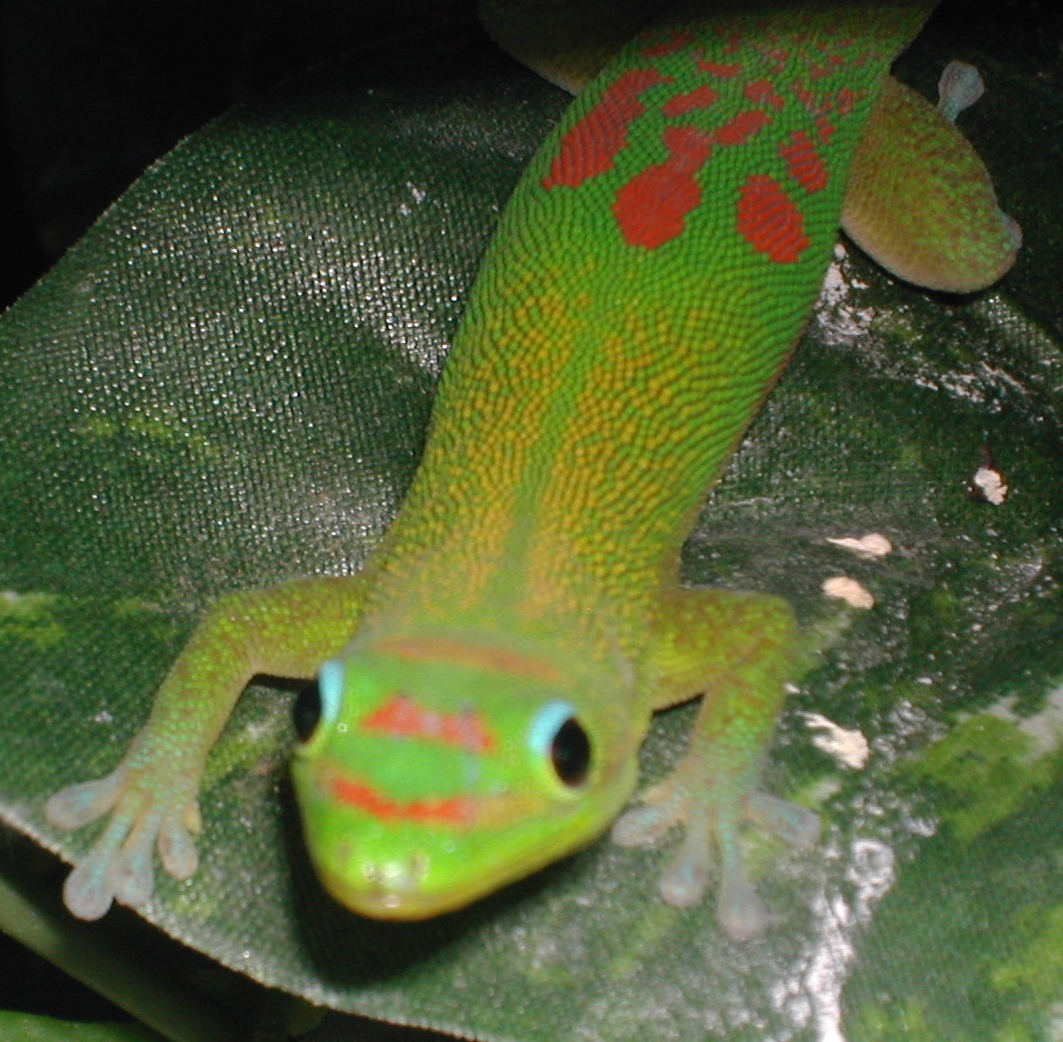Care of your
Day Gecko
Species:

Geckos of the genus Phelsuma have some fairly stringent care requirements, and beginning day gecko keepers should start with some of the easier to care for species such as Phelsuma madagascariensis grandis (Giant Day Gecko), Phelsuma laticauda (Gold Dust Day Gecko), and Phelsuma lineata (Lined Day Gecko). Even though many of the day geckos species have many common requirements, there are also many different care needs for certain species.
Hatchlings-
Hatchlings are generally hardy and
easy to care for, especially
if you obtain a captive bred animal. They do
well on a diet of crickets
of an appropriate size (for
hatchlings, eighth inch crickets or
smaller). The right size food item
will be no longer than the width
of the lizards own head. It is
important to supply vitamins and
minerals to your growing gecko.
This can be accomplished by “gut-loading”
crickets by feeding them such
items as orange slices, carrots,
salad greens, fish flake food, or
a commercially available cricket
food prior to giving them to your
lizard. Additionally, the crickets
can be dusted (coated in powder)
with a quality commercial
vitamin/mineral powder just before
providing them to your gecko to
eat. Hatchlings should be fed
every day to maintain a
healthy growth rate. It is a good
idea to vary the diet from time to
time by offering some other insect
prey such as mealworms, waxworms,
or butterworms. Remember to keep
the prey size appropriate and use
these worms sparingly, as they are
mostly fatty of chitinous. Most day geckos also eat fruits including papaya, mango, and fruity baby foods. It is easy to mix phosphorus free calcium and vitamin supplements right into the baby foods and should be provided at every other feeding. I
recommend keeping a small water
bowl available at all times, just
be sure to clean it regularly and spray the hatchlings 1 or 2 times a day to ensure proper hydration.
Adults- The adults are
maintained in much the same way.
Using a larger prey item feedings
can be scaled back to two to three
times a week. They don’t need
vitamin supplementation quite as
often either, maybe with every
other to every third feeding. You
can offer adult geckos an
occasional pinkie mouse to vary
the diet and supply a more
complete diet. This is good for
breeding females as well, to keep
on a little extra body weight to
compensate for reproductive energy
expenditures.
 General- Day geckos are diurnal (active in the daylight hours) which is in contrast to most other species of geckos. They are also very territorial and they are very colorful. These lizards come equipped with feet that allow them to climb vertical surfaces with ease. For this reason, a vertically oriented terrarium will be most suitable to keep them in. Most day geckos do not tolerate handling and should be thought of as a viewable pet instead of an interactive one. These lizards are great inhabitants for a well designed planted vivarium. At the very least, select a tall tank and provide many tall plants and bamboo, cork, or branches to climb on. Smaller species can be housed in a minimum of a 10 gallon enclosure for a pair of day geckos. Larger species should be housed in 20 gallon or larger enclosures for pairs of day geckos. Individual animals and juveniles can be kept in smaller enclosures. It is also important to provide proper ventilation in the enclosure while keeping proper humidity. General- Day geckos are diurnal (active in the daylight hours) which is in contrast to most other species of geckos. They are also very territorial and they are very colorful. These lizards come equipped with feet that allow them to climb vertical surfaces with ease. For this reason, a vertically oriented terrarium will be most suitable to keep them in. Most day geckos do not tolerate handling and should be thought of as a viewable pet instead of an interactive one. These lizards are great inhabitants for a well designed planted vivarium. At the very least, select a tall tank and provide many tall plants and bamboo, cork, or branches to climb on. Smaller species can be housed in a minimum of a 10 gallon enclosure for a pair of day geckos. Larger species should be housed in 20 gallon or larger enclosures for pairs of day geckos. Individual animals and juveniles can be kept in smaller enclosures. It is also important to provide proper ventilation in the enclosure while keeping proper humidity.
Temperature/Humidity- Most species of day geckos require daytime temperatures of 80 to 88 degrees Fahrenheit (27 to 31 degrees Celsius) and a nighttime temperature drop to around 70 to 75 degrees F (21 to 23 degrees C). A relative humidity level of 50 to 85 percent can be maintained by misting the enclosure several times a day. Keep a heat pad
available at all times on one end
of the tank. The day temperatures are best achieved with the use of incandescent lighting over the tank, and specifically positioned over slanted perches where the lizards are able to select their optimal basking temperatures.
Lighting- Adequate lighting is required for the day geckos and plants in the enclosure. Full-spectrum fluorescent lights should be placed at the top of the enclosure. Vitalights or other reptile fluorescent lights that produce UVA and UVB wavelengths of light should be used. Most types of plastic and glass block a large percent of UV light, so use these lights on a screen cover. An incandescent or halogen basking light should also be provided on one side of the enclosure over specific basking areas so that the gecko can pick its preferred temperature. Lighting should be controlled by a timer and varied seasonally from 14 hours per day during the summer to 10 hours per day during the winter, along with a small temperature drop for three to four months in winter.
Helpful Links:
www.phelsumania.com-species lists, care info, nice site!
Other Helpful Info:
̃
Always buy a healthy captive
bred animal and learn as much as
you can from the source that you
are buying it from, such as age,
sex, what is it eating, etc.
̃
Find a local veterinarian who is
knowledgeable about reptiles before
any problems arise!
̃
Buy a good book about Day
Geckos or at least a book with a
decent section about these
animals and keep it on hand for
reference. This care sheet
contains only initial
information to get you started
and is by no means complete.
̃
Enjoy your Day gecko! These
are fantastic and rewarding
pets.
Breeding- The breeding season is determined by temperature and photo period if the proper climate and diet are provided. As lighting hours and temperature increase in the spring, females should be provided additional food and supplements. Day geckos are either gluers or non-gluers. Non-gluers lay two or one calcareous hard-shelled eggs in a protected location such as a leaf joint or open bamboo section. Gluers attach the egg or eggs to leaves or other hard surfaces and are easily broken if an attempt is made to remove them. The eggs of gluers must be incubated in place unless the object to which they are attached can be moved to an incubator. Most fertile eggs can be incubated at a temperature of 82 degrees Fahrenheit (28 degrees C) with small variations in temperature and will hatch in 38 to 90 days depending on the species. Eggs can be hatched in an incubator by placing them on a small plastic lid placed on top of a bed of slightly moistened vermiculite (1:1 ratio of vermiculite to water by weight)
Recommended reading for specific species information:
‘Day Geckos in Captivity’ Leann & Greg Christenson 2003
'The General Care and Maintenance of Day Geckos' Sean McKeown 1993
'Geckoes' Henkel/Schmidt 1995 English version
'The Captive Maintenance and Propagation of Day Geckos' Tim Tytle 1989 The Vivarium 2-5
'Day Geckos' Eric M. Rundquist 1994
'Successfully Keeping the Smaller Day Geckos' Sean McKeown 1996 Reptiles 4-9
'Breeding the Smaller Day Geckos' Sean McKeown 1996 Reptiles 4-10
'Keeping and Breeding the Larger Day Geckos' Reid Taylor 1995 Reptiles 3-4
|